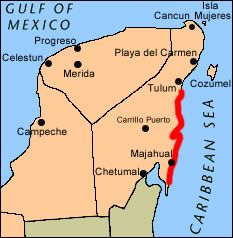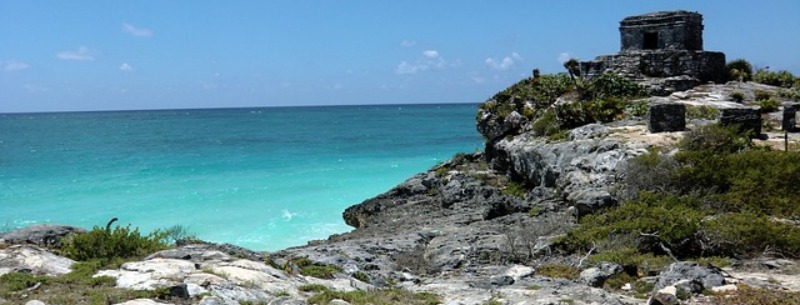The Riviera Maya on the Caribbean coast was a secret getaway to paradise for many years. No longer. Now it is considered one of the finest beach areas in the world.
Located on the Yucatan Peninsula in the state of Quintana Roo, the Riviera Maya is jaw-dropping beautiful. Although the area was only known to a select few for years, the last 10 years has seen a boom in tourism and resorts. Depending on your personal views, this is or isn’t a good development.
The best-known destination in the area is the beach town of Cancun. From Cancun, you can travel to the south down the beaches. Since the Riviera is not a defined area, it is generally agreed the town of Tulum is the southernmost point. Regardless of how you definite it, the beaches along the coast have something for everyone.
Riviera Maya is one of my favorites simply because of the beach, it is wonderful to enjoy the magic of the Riviera Maya and visit all the attractions it has to offer to you and your family. The Riviera Maya is a spot full of activities; once you are there you want to make sure you see the following:
Tulum
It is the only archaeological site that is next to the Sea, the Mayans decided to build a city-fortress of three walls of stone; the fourth one is just the sea’s protection. This place is considered one of the most beautiful in the whole Riviera; where luxury hotels and nature are combined for you to make an unforgettable experience.
Akumal
Akumal in the Mayan language means “Turtles’ Place”, being up to date the spot chosen by thousands of turtles to nest their eggs. This place is a bay of crystal clear waters, a paradise for divers all around the world. Here as well you can enjoy yourself with your family the sand, the Sea and the view.
Aktun Chen
These caves go through the heart of the jungle among vestiges of temples and cities. The legend says that it was the Gods’ desire to cover the land with light, bringing the waters to give birth to the trees, and thus become home of the birds of colorful plumage, who spread the seeds. Tapirs and Pheasants arrived and under the fearless gaze of the moon, the land was filled with tributes for eternal joy.
Mayan Riviera (Riviera Maya) beaches stretch along 100 miles of the world’s most beautiful pink and white powdered coral, from Cancun to Tulum. The Mayan Riviera is studded with some of the newest and fanciest hotel resorts as well as private, secluded bungalows and small hotels (some without electricity or phones).
Beginning at the “gateway” of Puerto Morelos, just 10 minutes from Cancun airport, the Riviera Maya ends at Tulum and its seaside Mayan ruins. The Yucatan is considered one of the 6 “cradles of civilization” and the crown jewel of Mexican tourism.
Its American “hip”, European “chic”, and Mexican “live and let live” tenor provides a “bohemian” flavor not found anywhere else in the Americas. Strolling the artists’ community of Playa del Carmen is an adventure in itself.
Far more ancient than Mayan ruins is the undersea world of the Palancar reef along the Riviera’s Caribbean coast. As the world’s second-largest coral reef, (after Australia’s Great Barrier Reef), the waters between the mainland and Cozumel are considered by many divers (including the late Jacques Cousteau) as the “best” on the planet. Visibility is almost unlimited and the marine life is usually very friendly.
Eschewing the frantic Cancun nightclubs environment, many vacationers (especially those with kids) are choosing the Mayan Riviera for the peace and quiet as well as the beauty of this tropical, beach paradise.
At Tulum, the superhighway suddenly turns into the dirt roads and jungle trails of the (as yet) pristine and undeveloped Costa Maya.
Costa Maya
The Costa Maya (Mayan Coast) is the last undeveloped section of the Caribbean Yucatan, lying between Tulum and British Honduras (Belize). Say “Goodbye” to the McDonalds and Walmarts of Cancun.
 The Mexican government is rapidly building highways and airports and delivering telephone, and electrical services to Costa Maya. The main highway (307), south of Tulum, slowly veers inland; but one can continue along the coast on poorly maintained dirt roads (4-wheel drive recommended).
The Mexican government is rapidly building highways and airports and delivering telephone, and electrical services to Costa Maya. The main highway (307), south of Tulum, slowly veers inland; but one can continue along the coast on poorly maintained dirt roads (4-wheel drive recommended).
Many foreign developers have begun to buy large tracts of the area; anticipating the interests of vacationers, retirees, and those seeking virgin beaches, escape, and an alternative to crowds and civilization. At present, however, there are many coastal properties with absolutely no development, waiting to be explored and exploited.
The Palancar Reef (second longest reef in the world) provides a natural barrier to this stretch of the Mexican coast, and home to over 500 species of fish, many varieties of coral, conch, sponges, anemones, and the sea turtles that nest on these shores.
The quaint Indian villages of Majahual and Xcalak, further south along Costa Maya, are departure points for scuba diving the “Chinchorro” atoll, birdwatching, and sport and fly fishing. A ferry operates from Chetumal (has a Holiday Inn) to Xcalak. Both Majahual and Xcalak have airstrips.
Puerto Morelos
Puerto Morelos, 15 minutes south of the Cancun airport, is the “Gateway” to the Mayan Riviera. The world-famous Palancar Reef, a couple hundred yards offshore, has been declared a national marine park. You can see the waves breaking on coral.
Development has skipped past Puerto Morelos. It’s as Cancun was 40 years ago, and the residents here are quite happy with that. The fine, white, powdered coral beach, the fishing pier, and the lighthouse, at the town’s edge, are the primary points of interest. There’s also a car ferry to Cozumel. Still primarily a small traditional fishing village, the boats bring in their morning catch to sell on the docks.
Downtown you’ll find restaurants featuring fresh fish and native dishes, a small medical center, pharmacy, grocery stores, handicraft shops, money exchange, and travel and car agencies.
Surrounding the village are modest homes, hotels, and cabanas. Accommodations range from rustic palapa style huts with thatched roofs and sleeping hammocks to air-conditioned all-inclusive resorts with health spas, jacuzzis, and swimming pools.
All of the Yucatan‘s most popular attractions including the archeological sites of Tulum, Coba, Chichen Itza, and the ecological parks of Xcaret, Xel-Ha, and Sian Ka’an are within 2 hours.
Tulum
Tulum “The Wall” was originally named Zama “Place of Dawning”. Silently overlooking the blue waters of the Caribbean, Tulum is Mexico’s most visited Mayan ruins. The only walled city built by the Mayas on the Caribbean coast; this was a thriving trading community when first visited by the Spaniards who reported it as grand as Seville.
Besides sunbathing on some of the best beaches in the world and swimming in the amazing Caribbean waters, you may want to visit the nearby Mayan Ruins or one of the many crystal-clear Cenotes — natural freshwater pools ideal for swimming, snorkeling or diving.
Located on the exquisite Riviera Maya, accommodations are 5-Star to “grass hut”; all-inclusive to mosquito nets and candlelight. The fine, white, powdered coral beaches and clear blue waters are some the finest in the world; and the lush tropical jungle of magic and illusion is your back yard.
Mayan Ruins
Mayan Ruins extend from the Yucatan peninsula to El Salvador, covering 5 Latin American countries and an area far greater than the Aztec empire. Long forgotten and shrouded in jungle, Mayan ruins are still being discovered today.
Playa del Carmen
Playa del Carmen is located in the heart of the Mayan Riviera, south of Cancun, and offers a convenient base of operations for many area attractions. In Playa del Carmen you can scuba dive, snorkel, ski, sail, rent a boat or mo-ped, para-glide, hot-air balloon, horseback ride, and take your choice of several jungle and eco-tours. Playa’s Palancar Reef represents a “Holy Pilgrimage” to many of the world’s wall diving enthusiasts.
Besides the ubiquitous native festivals and holidays, the larger resorts have theater and stage shows nightly. Although no longer a small fishing village; you can still walk from one end of Playa to the other in less than half an hour (with time-out for a Dos XX along the way). The laid-back “Bohemian” hipness has attracted large numbers of ex-patriot Americans and Europeans to settle here. “Playacar” has become a vibrant avant-guard artists’ community.
Forsaking the pressures of more conventional occupations, these well-tanned newcomers operate a small hotel and bungalow rentals, beachside bars, diving shops, and fishing charters, and indulge in a bit of e-commerce.
